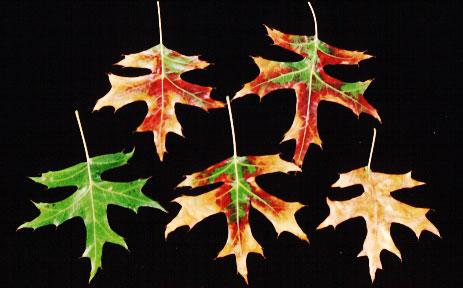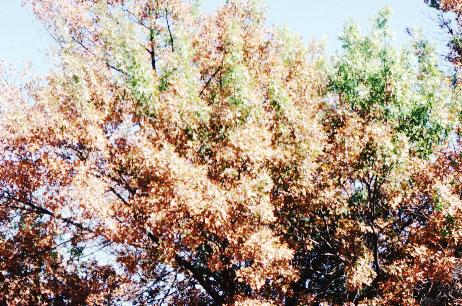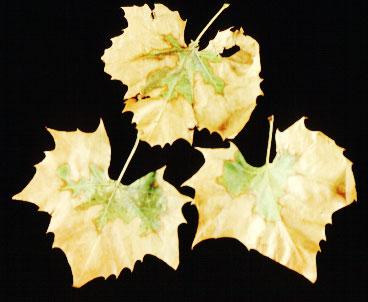General Information
Scorch or marginal burning on leaves of shade trees is an old problem. Only in recent years has a bacterium been associated with this problem, at least on some tree species. Pierce's disease of grape and phony disease of peach are two examples of this type of disease that have been recognized for many years but only in the past 10 years have we recognized bacteria as the causal agents.
The bacteria that cause these diseases are called fastidious xylem inhabiting bacteria (FXIB). Fastidious means that they are very difficult to grow on simple laboratory culture media. Within infected trees, they only occur in the living xylem or water conducting cells. These fastidious bacteria are generally gram-negative, rod-shaped and have no flagella.
In addition to grape and peach, scorch diseases caused by FXIB have been reported on elm, red maple, mulberry, sycamore, pin oak, southern and northern red oak, citrus and several stone fruits. Additional hosts will be found as more research work is done with this group of organisms. In North and South Carolina, this disease has been found on elm, pin oak, southern red oak, sycamore and grapes.
Foliar symptoms first appear in late July and early August as a brown or red discoloration around the margin of the leaf (Figure 1 and Figure 2). Initially only a small part of the tree canopy may show symptoms, but the symptoms become more severe each year as the bacteria move throughout the tree. The symptoms may first be noticed as early fall coloration on the foliage of one section of an otherwise green tree in late summer. Severe dieback and decline precede death of the entire tree in 3-4 years (Figure 3). Epicomic sprouts are also common on declining trees.
It has been demonstrated that the grass sharpshooter, Draeculacephala minerva; the redheaded sharpshooter, Xyphon (syn. Carneocephala) fulgida; and the bluegreen sharpshooter, Graphocephala atropunctata, are capable of transmitting FXIB from one host plant species to another. After feeding on an infected plant from two to 24 hours, the leafhoppers are capable of transmitting the bacterium to other plants (Freitage, 1951). Leafhoppers in these same genera occur in North Carolina. Draeculacephala antica, Graphocephala coccinea, and the yellowheaded leafhopper, Xyphon (syn. Carneocephala) flaviceps, all occur throughout the southeastern United States.
In addition, the leafhoppers Homalodisca coagulata, Cuerna costalis, and Oncometopia nigricans are vectors of both FXIB and phony disease of peach. It is thought that many species of leafhoppers (and some spittlebugs) are vectors of these bacteria and that their impact on eastern hardwoods is grossly underrated because of the small size of leafhoppers and the difficulty of observing them on the foliage of large trees (Drooz, 1985).
Control
Infected trees should be removed as soon as possible after proper diagnosis is made. This removes diseased trees that are sources of bacteria for insect transmission and possible transmission through root grafts. Do not replace diseased trees with the same species of tree.
References
- A Survey of Sharpshooters (Hemiptera: Cicadellidae) in Virginia Vineyards, a Region of Expanding Concern for Pierce's Disease. Wallingford, A. K. and D. G. Pfeiffer. 2012. J. Entomol. ScL 47(4): 360-365
- Insects of Eastern forests. Drooz, A. T. editor. 1985. USDA Forest Service Misc. Publication 1426. 608 pp.
- Pierces's Disease of the Grapevine. Schoulties, C. L. and D. L. Hopkins. 1978. Plant Pathology Circular No. 190 Fla. Dept. Agric. and Consumer Services, Division of Plant Industry
- Xyella Fastidiosa Transmission by Glassy-Winged Sharpshooters and Smoketree Sharpshooters from Alternate Hosts to Grapevines. Perring, T. M., T. R. Pinckard, and C. A. Farrar. 2007. Department of Entomology, University of California.
- NC State Extension Plant Pathology Publications
- NC State Horticultural Science Publications
- North Carolina Agricultural Chemicals Manual
For assistance with a specific problem, contact your local Cooperative Extension center.
Note on Recommendations
Recommendations of specific chemicals are based upon information on the manufacturer's label and performance in a limited number of trials. Because environmental conditions and methods of application by growers may vary widely, performance of the chemical will not always conform to the safety and pest control standards indicated by experimental data. All recommendations for pesticide use were legal at the time of publication, but the status of registration and use patterns are subject to change by actions of state and federal regulatory agencies.
Publication date: Sept. 23, 2024
N.C. Cooperative Extension prohibits discrimination and harassment regardless of age, color, disability, family and marital status, gender identity, national origin, political beliefs, race, religion, sex (including pregnancy), sexual orientation and veteran status.




